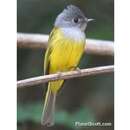en
names in breadcrumbs


The canary-flycatchers (Culicicapa) are a genus of birds in the family Stenostiridae. The genus was erected by Robert Swinhoe in 1871.[1] It is restricted to Southeast Asia. Canary-flycatchers have a fine-tipped bill which becomes broad and flat at the base. The sexes are indistinguishable in plumage. Young birds are neither spotted nor streaked.[2][3]
There are two species:
The canary-flycatchers (Culicicapa) are a genus of birds in the family Stenostiridae. The genus was erected by Robert Swinhoe in 1871. It is restricted to Southeast Asia. Canary-flycatchers have a fine-tipped bill which becomes broad and flat at the base. The sexes are indistinguishable in plumage. Young birds are neither spotted nor streaked.
There are two species:
Grey-headed canary-flycatcher, Culicicapa ceylonensis Citrine canary-flycatcher, Culicicapa helianthea